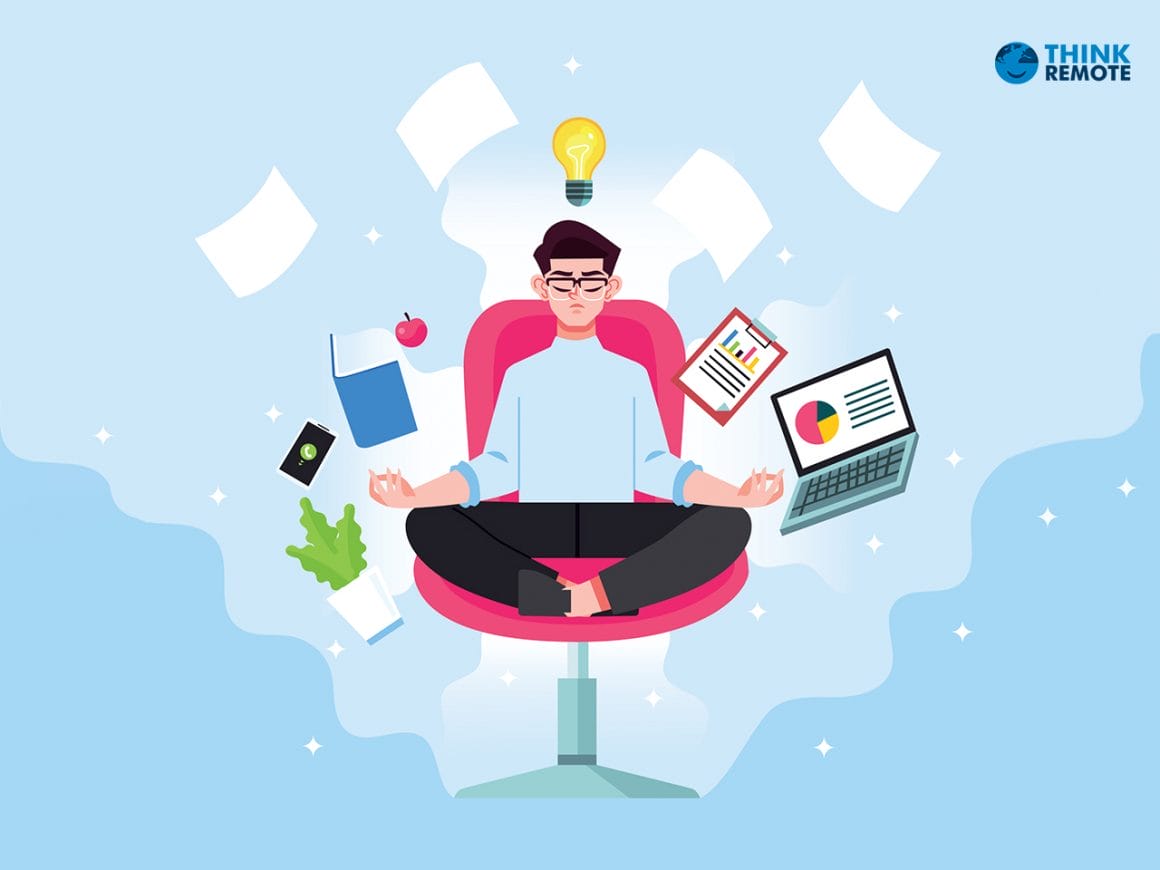Managing your time, adopting productivity hacks, and creating a more flexible work schedule so you can spend more time at home. People often describe work-life balance strategies as the perfect administration of these. But to understand this concept, you first need to understand its basis: balance. Quite a common term for us, right? But what does it mean?
What is Work-Life Balance, and Why is It Important?
To put it simply, work-life balance is the ability to combine work and personal commitments. Why are work-life balance strategies important? Simply because an inconsistent work-life balance schedule leads to burnout and overstresses in the workplace.
Without a work-life balance, you are more likely to feel exhaustion, energy depletion, negativity, and distance from work and family. As a result, you decrease your productivity, tasks pile up, and a growing feeling of inadequacy takes over you.
According to HBR.com, 94% of service professionals work over 50 hours a week. Especially in the US, most people think of themselves as workaholics – over 48% (healthcareers.com). It’s hard to imagine balance strategies with such a work schedule.
Furthermore, a work-centric lifestyle costs 190 billion dollars each year to reduce the physical and psychological effects (Forbes.com). Working daily for more than 8 hours has dangerous consequences, from spending less time with family and friends to eating unhealthy meals because of lack of time.
Here are 15 strategies to set work-life balance goals to save your mental health and boost your productivity over time:
15 Work From Home Strategies To Improve Your Work-Life Balance
The first thing to know is that a ‘perfect’ work-life balance strategy doesn’t exist. Ups and downs are part of life, and your priorities change with you. What you are looking for is an ideal balance strategy to improve your well-being over time.
Everyone is different. Instead of forcing the perfect routine to become someone else, you should set realistic work-life balance goals to build a healthier routine based on your needs. With time, you will find effective strategies to achieve an optimal balance between work and personal life.
Finding a routine that works for your it’s possible. Here are 15 strategies for three work-life balance goals to improve your schedule working from home:
Work-life Balance Goal 1: Visual Space

One of the most important things to improve work-life balance is separating different moments of your life. Working from home, it’s easy to lose the sense of time, and start postponing or mixing different activities of your life. For example, you keep in touch with your grandma while finishing a task. As a result, you take more time for work and feel overwhelmed even when your mum calls you.
So, the first strategy to improve your work-life balance is your home setup and daily schedule:
1. Build an Office Space That Works for You
If you work from home, it’s essential to create a dedicated working space. Creating a home office space will help you get focused and only think about work. So, when you leave your desk, you can focus on anything else in your life.
2. Keep Moving
Especially during the pandemic, most people started home workouts to improve their routine and stay active during lockdowns. And it’s an effective work-life balance to keep a schedule during your day. According to MedAlertHelp, 15 minutes of running every day reduces the risk of depression by 26%. You can train at home or have a walk in the park, as long as you keep moving to break your day and keep your schedule organized.
3. Forget About Eating While Working
Set fixed times for meals and breaks. If you start the habit of eating late at your desks, it will be harder to stick with your schedule. It’s important to leave enough time for cooking and relaxing from work. The important thing is to eat healthy food at home, respecting regular times.
4. Do Activities Your Enjoy
Leave at least one evening a week to relax by watching a movie, having a bath, or reading a book. It’s important to leave time for yourself to have more energy for your daily activities. Remember: life is more than just working.
5. Make Time for Your Loved Ones
Finally, meet your family and friends at least twice a week. Sometimes, it’s better to plan something you can’t skip. If you are late with tasks, you start procrastinating seeing your friends. As a result, you miss your social life and keep being late for work. So, if you find a nice show or a fun night, you don’t have excuses to miss the event. And you are more motivated in finish work on time to enjoy your night out without concerns!
In the midst of our busy schedules, finding time to cook nutritious meals can often seem like a chore. Opting for prepared, fresh-made, low-calorie meals can save valuable time and enhance your well-being.
Work-life Balance Goal 2: Mind Space

Visualizing the separation of your daily activities is essential to keep your focus during the day. Where is the point of having time for everything if you keep thinking about what to do next?
After you find space around you, it’s time to find space in your mind to optimize your effort without distractions:
6. Set Boundaries
Unfortunately, even remote work can save you from annoying colleagues. You will always work with someone who texts after normal working hours or the one who constantly needs something. The goal here is to avoid toxic work relationships that impact your routine. Setting boundaries is one of the most effective strategies to improve your work-life balance. Make sure to close with work when you are done, and reply only when it’s urgent. Establish your availability hours with your colleagues to make sure they respect them.
7. Avoid Distractions!
Setting boundaries is an effective strategy for you too. While working, avoid instant messaging and notifications. Social media and messaging distract your attention and slow down your workflow, making it harder to stick with your routine.
8. Track time
Especially if you are new to remote work, tracking time for tasks and work activities is a good work-life strategy to improve your daily routine. It’s a bit boring, but it gives you a sense of your day, helping you prioritize tasks and organize the day. For example, tools like TogglTrack, Hubstaff, or Clockfy are specific for remote workers, and their interface automatically connects with your accounts. They are a great solution to start tracking your activities and improve your work-life balance strategies!
If you work in or manage a team, it could also be worth looking into creating a resource allocation plan. This is a way for you and your colleagues to balance your tasks and increase the efficiency of your day-to-day output. A great thing to help you avoid burnout by having too much on your plate.
9. Unplug
Emails, social media, chats, WhatsApp are overwhelming. So, make sure to take an evening to unplug and dedicate time to yourself only. The point is to unplug from technology – and work. If you work for a remote company, you spend most of your time in front of a laptop. And then, you watch a movie or chat with long-distance friends. As a result, you spend most of your days in front of a screen. It’s important to include time to disconnect and unplug in your work-life balance strategies to keep your productivity high over time.
10. Keep Track of Your Activities
Besides tracking work time, it’s essential to monitor what you have done. For example, if you keep a notebook with each activity, you can check how much time you spend with family or working every month. So, you can visualize when you need to change or when your work-life balance strategies are working. In the long run, it helps you feel control over your schedule and be more focused and productive.
Work-life Balance Goal 3: Emotional Space

Finally, emotional stability is key for productivity and work-life balance. You cannot build a healthy routine if you spend your day worrying about everything. Here are five strategies to find emotional space and improve your work-life balance:
11. Forget About Multitasking
Multitasking sounds such a great skill to have, right? You can do multiple things at once and conquer the world in no time. In reality, multitasking can work only for a limited time. Working from home, jumping from one task to another usually leads to procrastination and burnout. And at the end of the day, nothing is done. Instead of rushing more things to finish earlier, do a task at the time until you finish. So, you won’t have the burden of half-done things after your finish!
12. Enjoy Your Free Time
Cultivating different interests is one of the best strategies to improve your work-life balance. From theater to ceramic, it’s important to save some time for something you like. We have to do most of our daily activities, from work to paying bills to being socially active. Leaving time for something you choose to do helps disconnect and recharge your energy.
13. Have a Side Gig
If you don’t want to focus only on work, you can start a side project about something you are passionate about. Or, you can volunteer for a cause you feel is important to you. It’s important to cultivate things that define you as a person, not only as a worker.
14. Build a Flexible – But Stable – Work Schedule
One of the best benefits of remote work is a flexible work schedule. Use it wisely! Instead of procrastinating everything, arrange your work time in chunks of three hours. You can use remote work flexibility to optimize your day and have more time for yourself.
15. Experiment with Different Work Routines
Things change, and so do you. Your life priorities won’t be identical forever. And your work-life balance strategies need to change with you. Finding a routine that works takes time because is an ongoing process. So, don’t worry if you realize that you need different things. Adjusting will take a while, but you will find another routine that works for you!
Last Thoughts About Work-Life Balance Strategies
Perhaps, the pandemic did one good thing. It helped us recognize the limits of our ‘old’ approach to work. For example, neglecting work-life balance strategies won’t bring us anything good. So, whether you are running a company or working for someone else, always remember the Jin and Yang principles. The challenge is growing professionally and personally without neglecting any of these sides of the coin!






